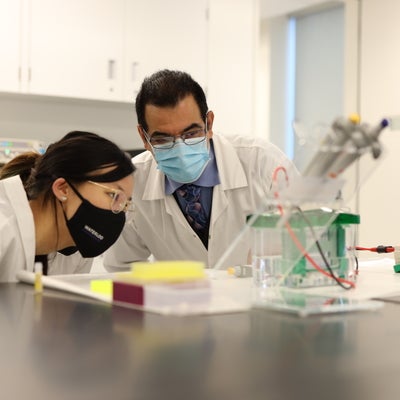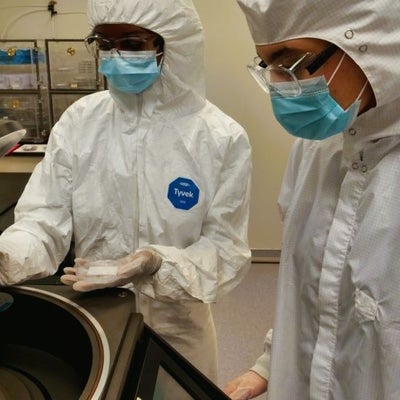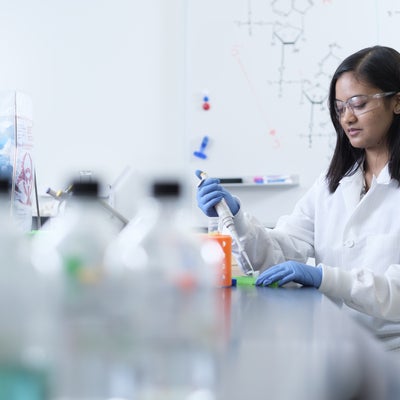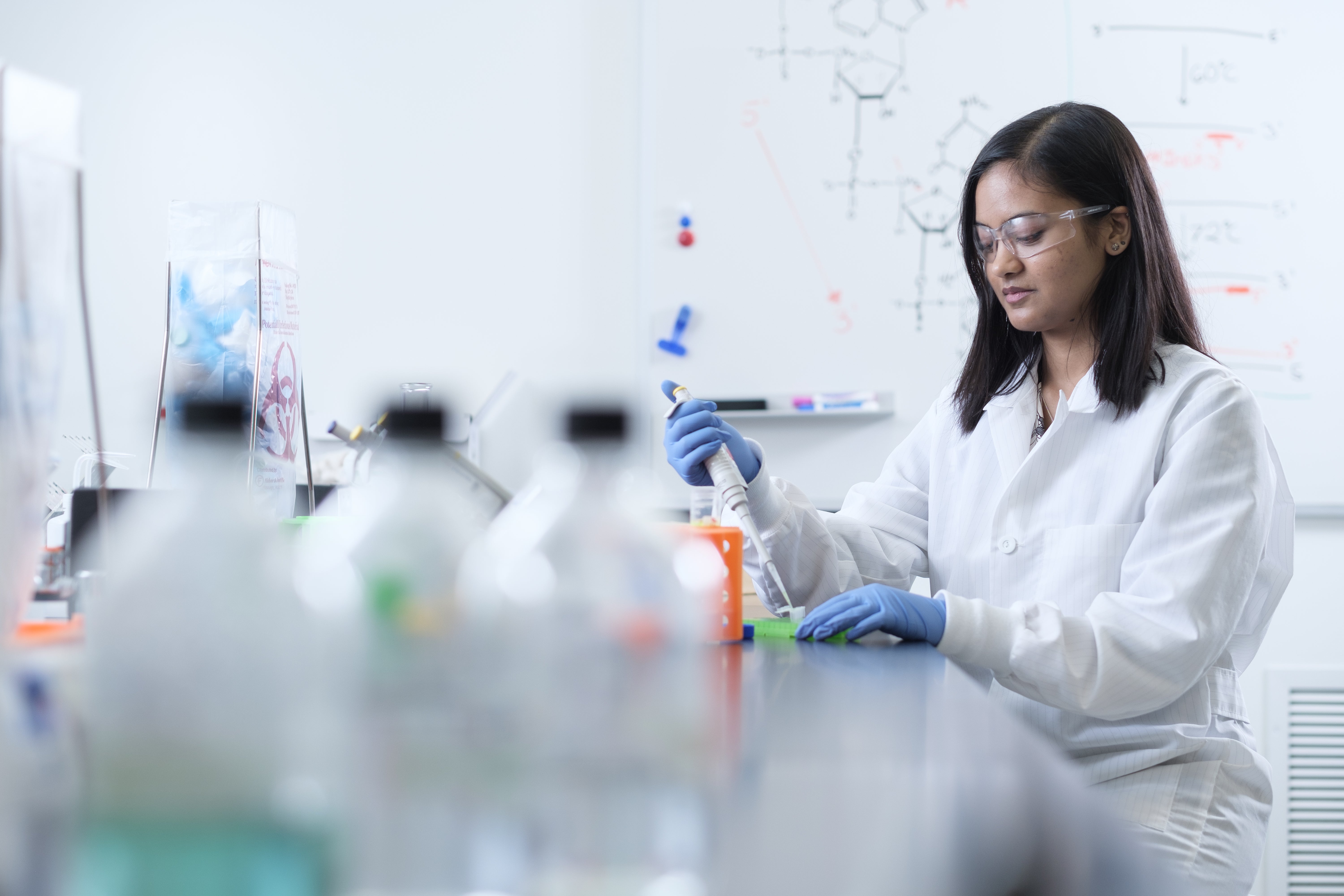Why Nanotechnology Engineering?
Nanotechnology Engineering is a multi-disciplinary engineering field, which draws from and benefits areas such as materials science and engineering, chemistry, physics, biology and medicine.
Nanotechnology has helped the world combat the COVID-19 Pandemic through the development of lifesaving mRNA vaccines. It also allowed societies to continue to engage in crucial business, educational and social activities during the pandemic in the virtual world through advancements in integrated circuits.
In Canada’s leading Nanotechnology Engineering program, you’ll use principles from biology, chemistry, electronics and quantum physics to create materials, biomedical devices and machines. You will work with materials far too small to see with the naked eye. During your time in Waterloo's Nanotechnology Engineering program, you will gain theoretical and practical knowledge and experience through labs, courses, and co-op positions.
Courses in Nanotechnology Engineering
Sample first-year courses
This is a sample schedule. Courses are subject to change.
| 1A Term | 1B Term |
|---|---|
Upper year courses
For information about courses past your first year, check out the Undergraduate Academic Calendar.
Customize your degree with options and specializations
Options
Options are a way to provide you with a path to expand your degree and get a secondary emphasis in another subject or area. Students should decide if they are interested in taking options as they enter second year. Some available options are:
Specializations
A specialization is recognition of selected elective courses within your degree. Specialization offerings are unique to your engineering program and are listed on your diploma. Specializations that are available to Nanotechnology Engineering students include:
Co-op for Nanotechnology Engineering students
You’ll have an unrivalled opportunity to gain paid work experience before you even graduate. We’ll help you navigate job applications, résumés, and interviews; you’ll have the added benefit of trying out different roles and/or industries to find the one that fits you while building your work experience and reinforcing your in-class learning out in the real world. It all adds up to a competitive advantage after graduation.
Starting in first year, you'll normally alternate between school and work every four months, integrating your classroom learning with real-world experience. You can return to the same employer for a couple of work terms to gain greater knowledge and responsibility or work for different employers to get a broad range of experience.
| Year | September to December (Fall) | January to April (Winter) | May to August (Spring) |
|---|---|---|---|
| First | Study | Study | Co-op |
| Second | Study | Co-op | Study |
| Third | Co-op | Co-op | Study |
| Fourth | Study | Co-op | Co-op |
| Fifth | Study | Study | - |
Your first work term will be at the end of first year. Learn more about co-op.
Example co-op positions for Nanotechnology Engineering students
- Battery materials intern
- Nanofabrication assistant
- Research assistant
- Quality project coordinator
- Material handler
- Optical development engineering
- Polymer engineering intern
- Food technologist
Small tech, big impacts: Researching with nanotechnology to make the world a better place
Shawn Benedict, Nanotechnology Engineering Student
Shawn Benedict (he/him) is a fourth-year Nanotechnology Engineering student who worked in a wide range of industries. He speaks about how co-op helped him solidify his career goals.
He shares, "In my first co-op, my favourite parts were working on the software and in my second co-op I found I really enjoyed working with firmware. Finding what I enjoy and where I would like to improve has been very helpful."

Example careers for Nanotechnology Engineering graduates
- Optoelectronic display engineer
- Materials test engineer
- Business technology analyst
- Research and development engineer
- Pharmacovigilance analyst
- Scanning probe microscopy experimentalist
- Nanoscale therapeutics development
- Implantable device design
Capstone design projects in Nanotechnology Engineering
Capstone Design is the culmination of the engineering undergraduate student experience, creating a blueprint for innovation in engineering design.
Supported by numerous awards, Capstone Design provides Waterloo Engineering students with the unique opportunity to conceptualize and design a project related to their chosen discipline.
A requirement for completion of their degrees, Capstone Design challenges students teams to push their own boundaries, and apply the knowledge and skills learned in the classroom and on co-op work terms. It reinforces the concepts of teamwork, project management, research and development.
For a full list of previous capstone design projects, see our Capstone Design website.
CelluSense (Capstone 2025)
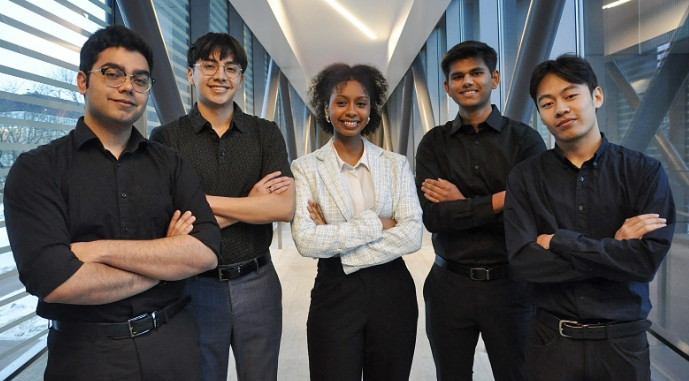
Leonardo Cabrera Ortiz, Nick Chung, Arjun Krishnan, Aseel Osman, Dhruv Patel
CelluSense redefines electromyography (EMG) with a sustainable and innovative approach, using graphitized cellulose nanomaterials as flexible, reusable, and biocompatible electrodes. Designed to address shortcomings of traditional Ag/AgCl single-use electrodes, it eliminates adhesive gels that can irritate skin while reducing medical waste. Integrated into a wearable compression sleeve, CelluSense offers superior conductivity, portability, and real-time muscle activity tracking for diagnosing and monitoring neuromuscular health, with applications ranging from hospitals to space stations. Advancing the UN’s SDGs, CelluSense promises a sustainable and user-friendly solution.
Fresh Wrap (Capstone 2025)
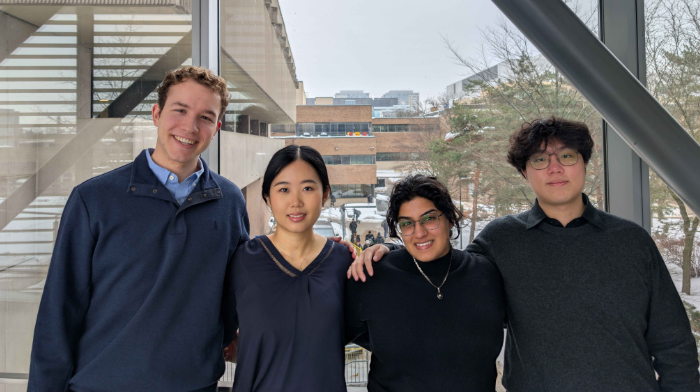
Samiha Chatoo, Peter Chen, Yujin Kim, Alex Magrath
One-third of all food produced for consumption is lost to spoilage. We aim to decrease that number by maximizing food longevity by incorporating zinc oxide nanoparticles into a traditional plastic wrap matrix. Zinc oxide nanoparticles (ZnO NPs) have antibacterial and antifungal properties that keep your food fresh longer without adding preservatives. Our design, FreshWrap, incorporates a uniform distribution of ZnO NPs in a low-density polyethylene polymer matrix while aiming to maintain ease of use.
Student design teams
The Sedra Student Design Centre consists of over 20,000 square feet of space dedicated to design teams and student projects. There are more than two dozen design teams, all of which are student-led, and many of which represent Waterloo internationally.
Some examples include:
Formula Nano

Formula Nano is dedicated to designing, building, and racing molecular machines at the nanoscale. We're working towards competing in the next international Nanocar Race where teams compete to race single molecules using a specialized scanning tunneling microscope.
UW Nano Research Group

UWNRG is a student-runned design team aiming to solve modern problems with nano solutions. Over the past few years, UWNRG has gone from competing in IEEE’s International ICRA competition to establishing its very own research group. Our current project involves designing and fabricating a FET sensor with graphene oxide gel for biosensing applications.
UW Silicon Integrated Optics (UWSiO)

UWSiO is a dynamic group of students focused on advancing and revolutionizing data storage through the use of silica systems. In an age of rapidly growing and often wasteful data production, we aim to develop solutions that are more efficient, durable, and scalable.
Nanotechnology Engineering alumni
Tina Dekker

Tina (class of 2017), "Nanotechnology Engineers from the University of Waterloo possess a unique set of skills and knowledge that enable them to connect ideas and leverage problem-solving tools from diverse disciplines. As a result, they are adept at addressing challenges in any industry or field".
Read more about Tina's time in Nanotechnology Engineering.
Mina Labib

Mina (class of 2013) sought a different path in engineering beyond the traditional roles he saw growing up in Kuwait. Drawn by Waterloo's strong reputation and the unique blend of disciplines in its nanotechnology program, he moved halfway across the world to study nanoscale technologies at the forefront of computer chip and microprocessing advancements.
Read more about Mina's time in Nanotechnology Engineering.
Farnaz Niroui

Farnaz (class of 2011) chose nanotechnology due to her passion for science and the program's interdisciplinary approach. The collaborative curriculum integrates key aspects of chemical engineering, electrical and computer engineering, and chemistry, aligning with her fascination for how materials at the nanoscale exhibit unique functionalities.
Read more about Farnaz's time in Nanotechnology Engineering.
Ryan Denomme

Ryan (class of 2010), "It felt like nanotechnology would define the future of a lot of industries,” Ryan says. “I knew that I would be taking a risk, because nanotechnology wasn’t as established as the more traditional forms of engineering, but I was willing to take that risk to be part of something new.”
Read more about Ryan's time in Nanotechnology Engineering.

